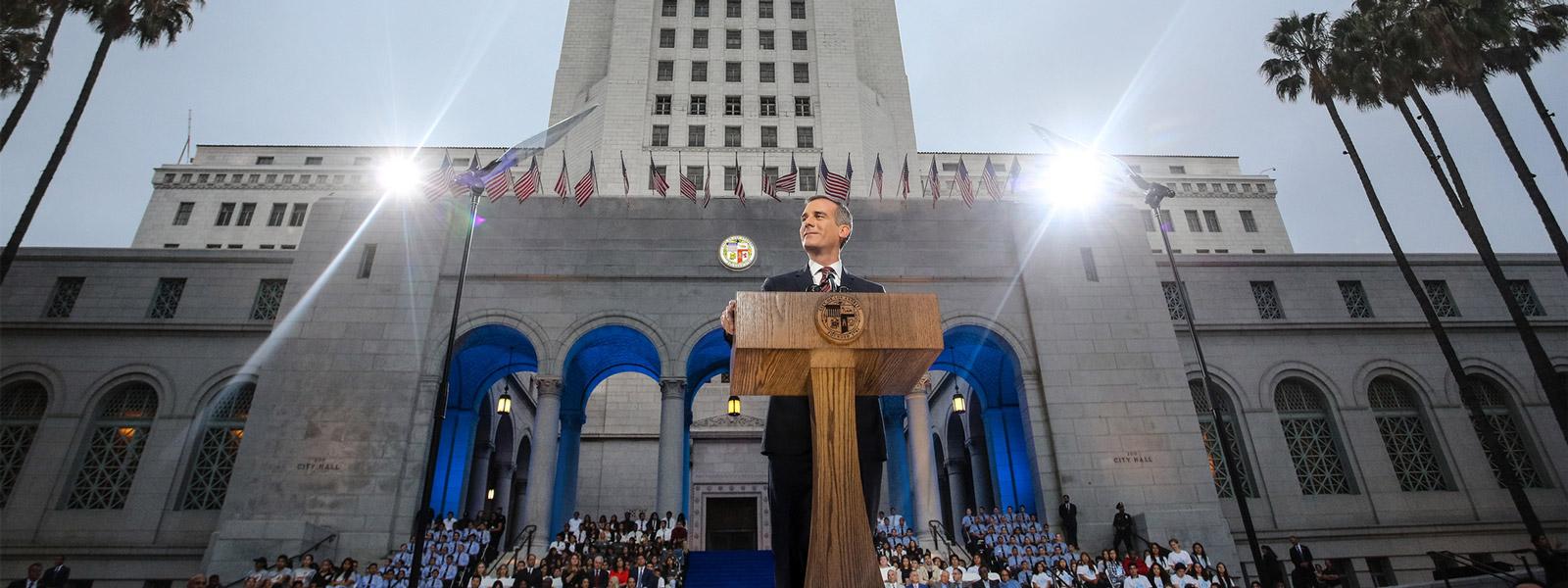
Rancho Palos Verdes, Trump National Golf Club. (Photo: Public Domain)
Rancho Palos Verdes Gets Some Help – Finally
The money to be offered is 75 cents on the dollar for a purchase
By Thomas Buckley, November 1, 2024 7:31 am
Gordon Leon was driving a Bobcat fixing his sewer line from his house to the drain on the street when he took a minute to talk to the California Globe about the recent announcement that Rancho Palos Verdes has obtained $42 million from the Federal Emergency Management Administration (FEMA) to try to mitigate the ever-expanding, ever-accelerating landslide problem in the city.
“It’s a step sideways,” Leon said Tuesday, referring to deal.
Not that it is bad, emphasized Leon, but he wonders about how the money is being spent.
That’s because FEMA awarded the city $42 million – money FEMA “found” leftover is its California January flood money budget – to buy ruined homes in the notorious slide area but will not allow that money to go to fix the underlying – literally – cause of the problem.
The city announced Monday that FEMA had awarded the money at a special town hall meeting but emphasized that the money is strictly regulated for the purchase of homes only.
Mayor John Cruikshank and City Manager Ara Mihranian said the money will go to buy out the most problematic properties; in other words those homes that have been the most damaged.
The funds will be awarded through essentially a triage system – the homes that have been “red tagged” as unlivable will the first eligible, the homes that have been “yellow tagged” by city inspectors will be next, and finally – if any money is left – homes that are technically livable but still seriously damaged will be bought last.
$42 million sounds like a lot of money, but remember this is Rancho Palos Verdes – the city estimates it will be able buy about 22 homes in total.
And right now there are seven “red tagged” homes in the affected area and a dozen or so “yellow tagged,” meaning there are most likely only a few spots left open.
Interestingly, when the program was announced there were only 2 “red” homes – the city has been offering free inspections since the announcement, a program some have taken up, others have not.
Note to homeowners considering asking for a city inspection: it’s a bit of a gamble, because if the results aren’t “bad” enough to get your home bought, it may still be “bad” enough to destroy what is left of your property’s value. Next Friday, the 8th, is the deadline to apply to be part of the program so it may be a good idea to pay for a “private” inspection before calling in the official city inspector because that, as you middle school teacher threatened , goes on your permanent record.
Another issue is the money to be offered – it’s 75 cents on the dollar for a purchase.
That sounds bad, but it may not be. First, the valuation is based on December, 2022 numbers, before the houses started really sliding away (the neighborhood, pretty much the Portuguese Bend area of the city, had been sliding for years, but nowhere nearly as bad as recently. Leon, who bought his house 25 years ago and will almost certainly not qualify for the buyout despite the movement, said until recently it was moving maybe 3 inches a year; now it’s – give or take – a half-foot a week.
In other words, the 2022 valuation is not as terrible as people tend to not to want to buy houses that move that much, even things described as mobile homes. So the price offered will – especially if it is “red tagged” will be more than could be obtained on the private market, even at 75% of the value.
Second, it is possible (the city is looking into the issue to finalize it) that the process may be tax free as they may be considered an eminent domain purchase. Eminent domain has a terrible reputation, in large part because it deserves it – silly purchases that take years to close (see high speed rail) and actually do nothing to benefit the community are terrible.
Even worse are the properties seized to benefit a property developer, especially when one considers the whole point of eminent domain was that it was legal and proper if fair market value was paid and the land was being used to expand a road or build a school or something. That was not the case in the now notorious New London, CT case and people were hounded out of their homes by the local government to make way for a private company rather than the public good.
Either way – good or bad – eminent domain funds are tax free – if the city can figure that out with FEMA, etc. that would mean that 75% of the value starts to look a lot more like at least 100% net.
Another questions that has plagued the city’s effort to get state and/or federal help until now (the FEMA is coming from a flood account it created earlier this year and was not actually completely used) is why to took so long.
Los Angeles County, like the state is, very very “blue” – one party rule state and that party is the Democrats.
Rancho Palos Verdes is not that way, It has a well-deserved reputation for being rather well-off, is (demographically speaking) rather white – about 62%, and comparatively Republican. Around the county, Democrats outnumber Republicans 3 to 1, in RPV Republicans have an ever so slight edge.
Is that why it took literally years for the disaster funds to flow? Politically probably. But the city is very hesitant – for obvious reasons – at the current moment to make that allegation themselves.
That leaves two questions – why and what’s next?
The why is simple – that area of the city has been a known slide zone for nearly 100 years, per a US Geological Administration survey. And then Los Angeles County did something very stupid – in 1965, it decide to extend Crenshaw Boulevard near the area and – by the moving of so much dirt – triggered the first of many slides and most likely triggered the “perma slide” residents have dealt with since.
When the city incorporated in 1973, it allowed building in the area until it imposed a moratorium in the 1980s (after it had created “abatement district” to have local homeowners try to pay a tax to fix the problem. By the way, to actually fix the problem is way way way beyond $42 million in cost.) The issue went to court and the landowners won and building started again.
The newer homes (and some of the older homes have been retrofitted) to, in an odd way, go with the land as it moves (waaaay oversimplified) making building in the area not as silly as it sounds – in other words, the folks who build yet another house in the Outer Banks of North Carolina after they lose yet another to a hurricane are still entitled to FEMA money, so why not RPV folks?)
There is also one other issue confronting the city as it moves through this program – the issue of property lines. While most of the lots in the affected are pretty large – think half-acre at least – the distance the homes have traveled recently are, occasionally, technically – according to the recorded map – on someone else’s land and they will not be eligible for FEMA assistance.
(As a former city official, I can personally attest to the absolute legal, political, and logistical nightmare of going back and trying to re-draw lot lines, so that will be a problem going forward.)
While this may not be a perfect answer, Cruikshank and Mihranian see it as at least a move forward and said that the city will not stop trying the raise funds to fix the problem and will keep pressuring Southern California Edison to move far more quickly to re-attach power to about the few hundred homes that are still without.
Overall, said Cruikshank, “It seems like a decent deal.”
At least for now.
- Benefit Fraud Problems and Solutions - November 7, 2024
- A Little Exit Poll - November 5, 2024
- Tomorrow’s Headlines Today! - November 5, 2024





In the mid 1980’s I golfed at the now named Trump National Golf Club. Back then it was just a public course.
I don’t know what it cost to play there but it couldn’t have been much, because I wouldn’t have paid much; maybe $20 (just a guess). To me, golf is golf. The location makes it special.
Back then the main road around the point of PV was always be repaved because of the earth moving. old yellow dividing lines in weird places, because of the movement.
it’s 250 now, but still apparently worth it as a onetime thing
there are certain local/veterans/junior discounts..
pebble beach is about 6-700 bucks
We have family members who used to live in Rolling Hills Estates not too far from Rancho Palos Verdes. Their house was unremarkable 1950’s tract home but it was built high on a hill with a stunning city view and a partial ocean view. Almost every week they would find new cracks in the walls and concrete that would have to be repaired. They sold the house for a tidy profit about five years ago because they feared that it would come crashing down the hill one day.